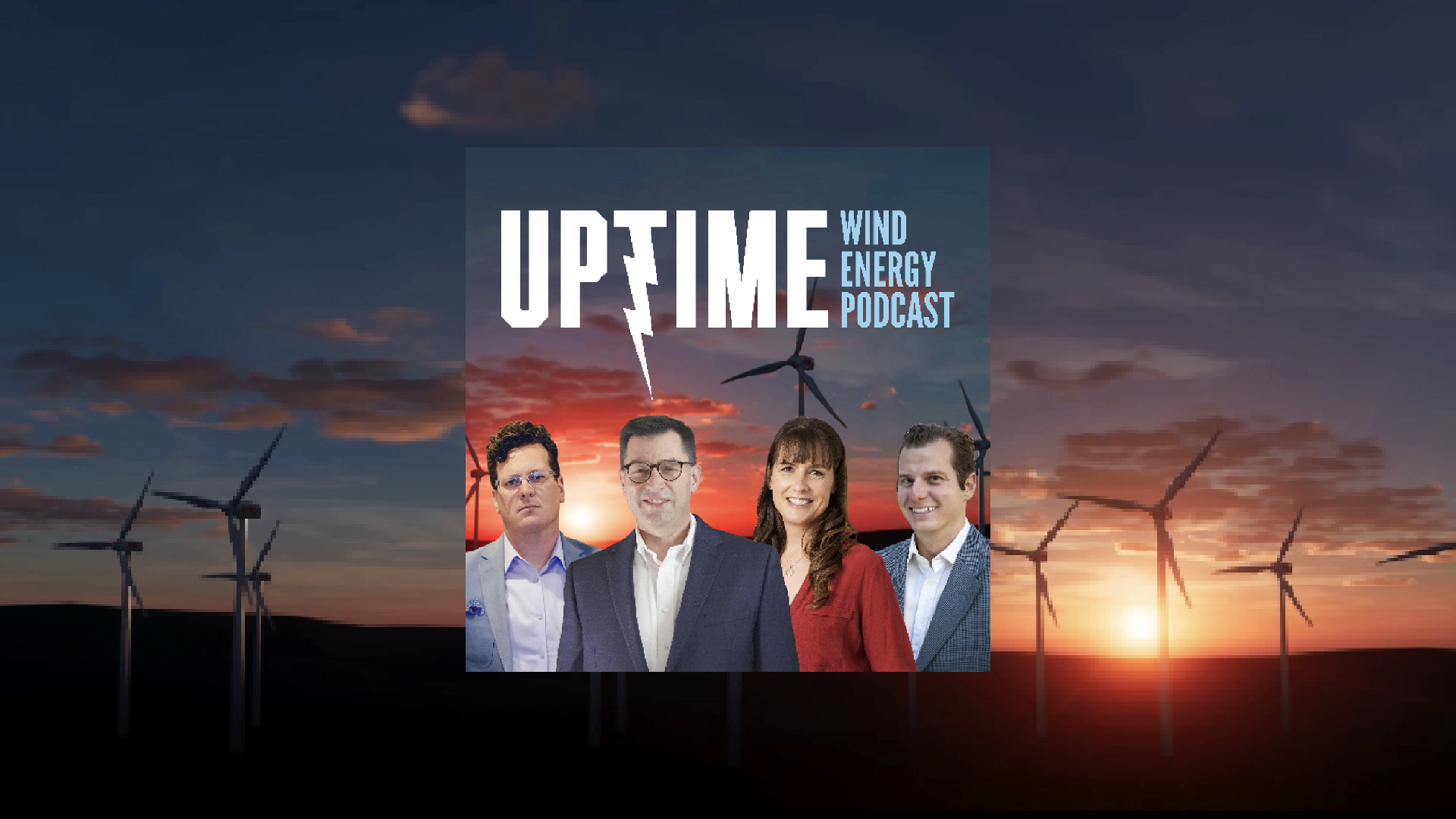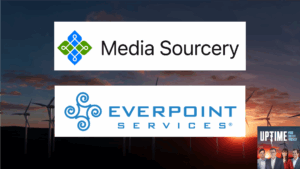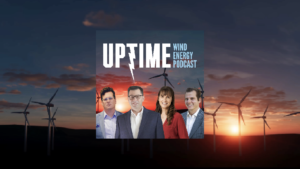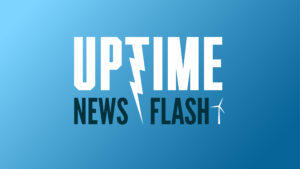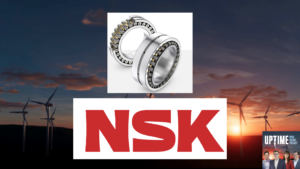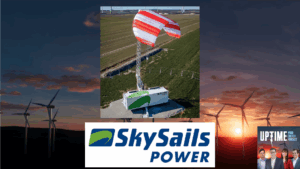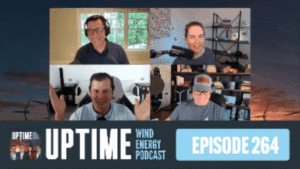Podcast: Play in new window | Download
We discuss a PES Wind Magazine article featuring 4cast’s methodology for comprehensive wind resource assessment and site planning. Then cover Vestas CFO Hans Martin Smith’s departure after 20+ years. Finally offshore wind security concerns follow a Chinese vessel’s severance of Baltic Sea cables, and Tilt Renewables is announced as the title sponsor for Wind Energy O&M Australia.
Sign up now for Uptime Tech News, our weekly email update on all things wind technology. This episode is sponsored by Weather Guard Lightning Tech. Learn more about Weather Guard’s StrikeTape Wind Turbine LPS retrofit. Follow the show on Facebook, YouTube, Twitter, Linkedin and visit Weather Guard on the web. And subscribe to Rosemary Barnes’ YouTube channel here. Have a question we can answer on the show? Email us!
Pardalote Consulting – https://www.pardaloteconsulting.com
Weather Guard Lightning Tech – www.weatherguardwind.com
Intelstor – https://www.intelstor.com
Join us at The Wind Energy O&M Australia Conference – https://www.windaustralia.com
Allen Hall: Well, since everybody is getting pardoned recently, uh, I thought it may be a good idea to, to put out there what we should be pardoned for, so we ought to get added to that list.
Joel Saxum: How about this one? I would like to be pardoned for not getting my better half’s windshield changed in her Jeep from the crack from it.
Allen Hall: Ooh, you’re gonna need a pardon for that. Yeah, that’s, that’s definitely pardonable material. Yeah. Phil, have you broken any scooter laws there in California? No, I have not. I don’t know, Phil, you ought to get them out now because the pardons are coming. Okay. Well, Rosemary, I’m not sure we can pardon anybody in another country, but we might as well just open it up to everybody right now.
Why not? Rosemary, did you commit any offenses when you were in the States, in California, studying composites?
Rosemary Barnes: I’ve got a pretty big one, actually. I don’t know if you guys have this, but in Australia, when you’re learning how to, to write, handwrite at school, you know, you start with a pencil and then when you pass a test and you can graduate up to a pen, you need a pen license.
Um, do you have that?
Allen Hall: That is not real.
Rosemary Barnes: I did not get my pen license, but I do write with a pen sometimes. So, yeah, including in the United States.
Philip Totaro: That’s as real as a hoop snake.
Rosemary Barnes: That’s true. And I, um, I would like to invite Australians to comment on if you’re watching this on YouTube or anywhere that you can write comments but look it up on the LinkedIn post about this episode.
Please comment and confirm that we do or at least did in the 90s. I have to get a pen license before if we graduate from pencil to pen. I never got it.
Allen Hall: It’s a scandal. It’s an outright scandal. Alan, you have to share yours with us. What are you, what do you need to be pardoned for? Yeah, we could use some pardoning on the production side of the Uptime Wind Energy podcast because there are, there have been some times it’s pretty rough to edit and I gotta, I gotta plead guilty.
Yes, it is. However. However. Our producer does a very fine job, and what comes out on the airwaves is much better than what we record. Clearly. In
this quarter’s PES Win Magazine, a number of great articles, and you can download all of them at PESWin. com, but A really interesting article about weather from a company called Forecast. So if you go to their website, it’s fore cast. de, they’re based in Germany. And the article really describes how you do forecasting.
Preliminary studies on wind sites to look at what the winds are now, get a really good understanding of that and how that plays into the yield of this farm and what the weather should be, the long term weather implications going forward, so you can at least have an estimate on the revenue you’re going to pay.
Possibly be generating from these wind farms. And Joel, it seems like a lot of wind farm operators don’t do this. Either they don’t
Joel Saxum: do it or they’re not doing it at a high enough fidelity, right? So they’re not doing it well enough. We run into some wind farms where all of a sudden, you know, the resource is down or the resource isn’t good enough or local competition for the wind resource, right?
Someone’s building wind farms around them and it changes. And you, you see some people kind of, yeah, generally it looks like this at a hundred meters or at 80 meters. This is what we should have. And then they move on. Um, but what you’re seeing now is more sophisticated lenders as well. Wanting really good bankable insights on what is that wind resource going to be?
How much profit are we going to generate out of this project? Um, you know, and there’s other things that factor into that, which, uh, forecast is taking into consideration when they do their estimates. Legal framework and regulations, right? Because that’s a part of a wind or a site assessment as well, because as those things change or develop depending on where you are, you may be used to doing wind in Texas and you move to Kansas.
It’s a completely different regulatory framework, so that’s a big part of it. Uh, but, you know, if I’m building a wind farm, this is the kind of thing that I want to make sure that I tackle in a really good way. I don’t know if they do this, but I know, Alan, you and I talk about it would be nice if people would do lightning, lightning, uh, density as a part of their sighting assessment, but We’ll see.
Allen Hall: Well, there’s less lightning strikes in Europe, in most places in Europe, than there is in the United States. But Europe does seem to have a history of doing more research on the sites before they decide to put turbines in, where in the States, there are assessments done, but maybe not the fidelity of what Forecast is doing here.
Rosemary Barnes: In Australia, at least. I know that they do do lightning assessments, but, um, they don’t use it for estimating how many lightning repairs that you will need on blades or anything like that. It’s for, um, you know, they need to assess the lightning and protect the substation and things like that and make sure people aren’t going to die from lightning strikes on the site.
Um, so I know that I, I’ve seen the, you know, initial assessments and when you had all the information there, it would not have taken very much for you to extrapolate to realize that you were going to have this big lightning problem on site. Like you should, you should have known before you stuck a single turbine in the ground that you’re going to have, you You know, a lot more, um, lightning repairs than, you know, other sites that you had that had a lower lightning strike, um, intensity.
So yeah, I, I didn’t even think it would add that much more to the development process. If I just need to get the right expert in to, you know, just take a quick look at it and say, Hey guys, might budget in some, um, you know, more lightning repairs than you might be used to.
Allen Hall: Yeah, there’s a recent article about wind farms in my area that are on ridgelines.
They’re having huge problems with gusts. And they’re now realizing that maybe gusts aren’t the best thing for wind turbines. Maybe we didn’t site these turbines right because Half of them are down at any one time.
Rosemary Barnes: That’s, that’s one thing to not check the lightning, uh, environment, but to not check the wind resource properly is a bit strange for a wind farm.
Allen Hall: I agree. Uh, there’s been a huge shift in whether, uh, wind turbines should be cited on gusty sites or on top of mountains. There’s, there’s a lot less of the on top of the ridge lines and there were, uh, 10, 15 years ago, which is when our turbines were installed. So, you know, getting those wind resources right is a huge advantage.
And if. If you want to go to a resource, you can go to PESWin. com, read the article from Forkast.
As busy wind energy professionals, staying informed is crucial. And let’s face it, difficult. That’s why the Uptime Podcast recommends PESWin Magazine. PES Wind offers a diverse range of in depth articles and expert insights that dive into the most pressing issues facing our energy future.
Whether you’re an industry veteran or new to wind, PES Wind has the high quality content you need. Don’t miss out. Visit peswind. com today.
Allen Hall: Well, an interesting departure from Vestas. Hans Martin Smith has left the company after 20 plus years at Vestas. Um, he’s a CFO who began that role in about two years ago, March 22, and was really instrumental in Vestas, uh, coming back into profitability in 23 and looks like 24.
Uh, they’ve installed another person temporarily as CFO for the company. But this has rocked the stock market a little bit. Uh, the stock price was down the day of the announcement at about 10%. We’ll see what happens over the next couple of days to see if it recovers. But this is a real, uh, unique development, I think.
We’ve seen wind energy companies really struggle lately, but we haven’t seen key players, uh, walk off the court, which is what just happened
Philip Totaro: here, Phil. I mean, there, we don’t really know at this point as we record what the were for the departure. Uh, clearly Wall Street doesn’t like it because they prefer certainty.
Um, but when you consider, you know, their, the divestitists had a bit of a hard time and, and it’s getting a bit clobbered with, uh, you know, a lot of these, uh, warranty claims and, and, uh, Uh, not accurately predicting the extent of, um, you know, their, their liability issues on the services side of the business.
You know, they’re, they’re still making orders, uh, globally. They’re, they’re obviously still behind, you know, Gold Wind, um, internationally, uh, as far as, you know, global league tables and all that sort of thing. Um, but their services business has been, uh, a bit of, uh, thrown in their side, um, in the past few years.
So, uh, you know, again, I, we really don’t know what this is related to. Um, but that’s, as far as their commercial business goes, I think that’s probably the only thing, uh, on the commercial side of the business that, uh, anybody could say, you know, hey, you’re, you’re underperforming and it’s time to bring in some fresh blood.
If that’s what happened.
Joel Saxum: I think something that’s interesting here is that we know, like, you know, back in 21, they had the big write down with some of the lightning protection system issues that they had, uh, you know, some couple of lawsuits and stuff there. But in the last year, news cycle ish, we’ve heard a lot about Siemens Gamesa and their problems.
We’ve heard a lot about GE Vernova and some of the, some of the big moves they’re making with, you know, just pausing on some offshore wind and their shakeup with, uh, some of the. The C suite around there, um, and Vestas has kind of flown under the radar. But when you look at the, the wall street side of things, all of those major manufacturers of wind, like when anything happens with them, wall street, the investors, everybody is super apt to make a change real quick because it’s almost like the volatility index of each of the, of the wind sector is pretty high.
So you’re people watching, watching, watching. So when you see an announcement like this and something drops 10 percent like that. A lot of times it’s a knee jerk reaction. I wouldn’t expect that to keep tumbling in at that rate. Now we do also know that Vesta stock in the last year has gone down a little over 50%.
Um, and I think that that’s just a, I mean, they’re a pure wind play, right? And there’s been some headwinds in the sector on the OEM side. So. It’s kind of expected, but, um, I wouldn’t expect to see them keep just, I mean, I don’t expect another 10 percent tomorrow. Uh, but that’s, that’s me again, as we, as we always say, not investment advice.
So don’t, don’t take that one for granted. Um, but Vestas as an OEM, I mean, they’re still there. The order book is still there. They’re still chugging things out. Um, they’re still, uh, looking at some offshore things. So, I mean, I don’t, I don’t think there’s a massive, this isn’t a massive hurt to the, uh, actual bottom line of Vestas.
I think it’s, um, they’ll replace
Allen Hall: them and keep moving on. Their earnings before interest and taxes are, the margin is about 4 to 5 percent, uh, at the moment. They’ve been looking to get that to grow to 10 percent margin, and so they’re about halfway there. To get to 10 percent earnings before interest and taxes margin is, would be remarkable for that business.
It’s, it’s a hard thing to do because you get, you know, Really two buckets to play with. You can charge more for the turbines, which Vestas clearly is doing right now. But on the other side, trying to reduce supply chain costs and drive down the expenses internally, even labor costs, uh, is really difficult.
And in the inflationary environment we still live in, with the raw materials being mostly steel and copper and Obviously, the composites needed for Blades, those prices are not really going to change that much. The CFO is kind of stuck in the middle of
Joel Saxum: that, right? Yeah, I think he’s, he’s taking fire from all corners, right?
You got the board looking at you, you got investors looking at you, you’re kind of trying to I think, I think at one point in time we have to look at this like, um People are human too, right? And sometimes maybe you just said, you know what? I’ve had enough of the stress here. I mean, we, if you follow the news today, there was a high powered C suite executive that was murdered on the street, the United Healthcare CEO, right?
Like that kind of stuff is that’s, that’s ridiculous to be the head of these companies and imagine the stress these people are under and have to go through. And maybe he decided, you know what? I just want to. Take a little time with my family and do something a little less stressful. So that could
Allen Hall: be the reason too.
Here’s where I think that that didn’t happen because Vestas being the company that they are and always planning ahead would have had a plan in place that would have not gone wrong. allowed the stock to fall like that. They would have had more rationale as to why this is happening because the initial assumption from everything you saw online was, uh, he has been asked to leave, which is not, there was no data to back that up.
So I, I’m also wondering like you, Joel, is that just guessing at the market and trying to get a leg up on where you think Vesta’s stock is going? Because there’s no indication of anything right now. It’s just that he’s going to leave the company and at the end of 24 and that’s it. So from a Vestas standpoint, obviously as a lot of people work at Vestas, it’s a very strong company.
Uh, it just seems really hard for them to get to a 10 percent EBIT margin. That would be incredibly hard to be in that position. And who knows, you know, there’s a lot of moving pieces with Vestas at the moment, maybe, um, yeah, changes, more changes are likely to happen. Who knows?
Lightning is an act of God, but lightning damage is not, actually is very predictable and very preventable.
Strike tape is a lightning protection system upgrade for wind turbines made by WeatherGuard. It dramatically improves the effectiveness of the factory LPS so you can stop worrying about lightning damage. Visit weatherguardwind. com to learn more, read a case study, and schedule a call today.
Allen Hall: Although we haven’t heard a lot of news about this in the United States, uh, you know, NATO warships surrounded a Chinese bulk carrier in the Baltic Sea not long ago because, uh, of fiber optic cables, one from Sweden to Lithuania and one between Germany and Finland.
were severed as this Chinese ship drug an anchor across them. From what we can tell, uh, as Joel pointed out, they turned off the vessel’s transponder during part of this. So the boat tried to disappear a number of Surrounding countries, including Denmark, got pretty suspicious when this was going on and ran out to, to find out what this ship was up to.
It looks like they were, they drug an anchor about a hundred miles, roughly. And that is a huge problem. Uh, you can sever a lot of things. And, and, and I think Joel, I think you originally pulled into this out to me that it looked like the, the ship was making some circles around this cable. One of these cables, just trying to.
happened to find it where he could sever it. Now, there’s been a number of investigations in this and obviously maritime rules exist, so there’s not a lot that can happen here because the the type of ship and what it’s carrying it’s it has Russian fertilizer on it and it has I believe a Russian Captain or a Chinese?
No, it has a Chinese. Sorry. It has a Chinese captain and at least one Russian sailor. Yeah Uh, but they, they can’t bring the ship to port because of maritime law, so they got it parked out there. Denmark has it parked, uh, just off their shores. The big question is, this is the second time this has happened.
What happens to an offshore wind farm? Where there’s a lot of cable laying on the bottom of the ocean that’s providing power, not just internet, and this fiber optic was carrying internet, of course. What happens in those situations and is there ways to protect the power cables and all those connective cables that run between the individual turbines, inter array cables, to protect them from Yeah,
Joel Saxum: I think to, to, to understand the risk there, we’ve got to think about how these things are put in the water and what it looks like.
So there’s a big difference between, say, you know, one of these big, you know, inter, intercontinental cables and what a local cable looks like. And the odd thing is, is it’s actually less aggressive. Protected. These big intercontinental cables are less protected than local ones are. Because to do, like, so, when I say protected, I mean rock dumps.
So you lay the cable and then you dump rocks over them. Or you could put what’s called a mattress over them. Which is basically just like, um, a lot of times just a hunk of concrete that kind of shields them. Um, or of course you have bearing them. So you use a subsea trencher or in a, you know, in a transition zone where you’re going from deep water up on the shore, you might, you know, might actually, uh, horizontally drill for them.
So. So, these big communications cables, a lot of times that were laid 50 years ago, they don’t have as much protection on them, uh, as the new stuff does. So, when you do a wind farm, you, there’s a lot of, because now we know, you know, we learn from our mistakes. So we know we need scour protection, we need to make sure that these cables are protected, and make sure that we’re not, um, uncovering them because of bend radiuses and all the bad things that can happen.
So if you were to go into an offshore wind farm today and you looked at, let’s say just like inter array cables. So inter array cables being the cables from each turbine, say to the offshore substation, the majority of them are going to have a rock dump on top of them. Um, or like a Ridgeway rock bags, kind of like, um, engineered piece of, you know, rock or concrete that covers them.
So they’re kind of protected. Um, and then you’re going to have the big export cable, which goes from the offshore substation to land. Okay. Uh, to wherever they’re, they’re, they’re beaching this thing at. And those will, should usually be buried a lot of times because that’s going to be a bigger cable. Uh, wanting to be protected more.
Um, so they’ll bury it until they get into a certain water depth and then they’ll trench it into, use a trenching machine or a horizontal drilling machine to bring it into shore. So I do think that, and I would say that possibly in some of the older offshore wind farms, there’s the possibility of a ship coming through there and dropping an anchor and dragging some of these cables.
Or if the anchor’s big enough, you might just, you know, plow the rocks out of the way and drag the thing anyways. So from an infrastructure risk standpoint, you know, of course we have insurance and all these things to cover this stuff, but what could really happen is, you know, a targeted attack is not out of the question in my mind.
Um, I mean, we’ve seen them on onshore for substations, right? Uh, like a targeted attack is pretty easy to do. Um, it’s just how bad are the, uh, operators that I don’t, I’m not saying operators of the wind farms, but the international operators that don’t want that wind farm to, to, uh, Bring its power to shore.
It’s, it’s possible.
Allen Hall: Phil, have you seen any design data or patents in regards to anchor, uh, catchers, I’ll call them? Something that would stop an anchor from dragging onto a cable, some sort of preventive device? Nothing
Philip Totaro: for, uh, offshore wind farms specifically, but what I’d like to go back to is the, the risk level.
So, interarray cables, in order to drag something through there, you’d have to get a vessel through there that would You know, be able to fit, uh, first of all. The other thing is, wind farms are usually outside of the rather highly regulated shipping lanes, and while there isn’t always somebody out there patrolling 100 percent of the time, I mean, most people aren’t going anywhere zigzagging through wind farms, dragging an anchor.
So, now, that said, the export cables, as Joel said, they’re already reasonably somewhat protected, but they’re also more exposed because they could intersect with shipping lanes. Um, I know even in like New York, New Jersey, where we’re talking about putting some offshore wind farms, they’ve had to kind of circuitously route the cables to avoid the shipping lanes, the New York Bight.
Um, and it’s, it’s, you know, caused a lot of consternation because then there’s people in like Long Beach, um, You know, that don’t want the cable landing point there, uh, they’re trying to get it, you know, sent off to somewhere in Delaware or Maryland or what have you. And it, it’s, you know, causing, uh, causing all kinds of discussions.
But, uh, you know, the, the possibility, as Joel said, the possibility of it happening is there. I, I think actually the, the more interesting thing with like offshore wind farm security would be proximity detection for things like submarines. Which might actually be a riskier thing where they could go in, they could deliberately find and cut a cable, um, you know, as opposed to, you know, some, some Chinese flag vessel that that’s just dragging an anchor and going in circles.
I mean, that’s one way to do it. Um, but for an offshore wind farm, submarines are probably, you know, foreign submarines are probably a bigger risk than, um, you know, intentional or otherwise the, the random anchor drop and drag through, through the, uh, the ocean.
Allen Hall: Are there sensors? Right? Are there sensors on foundations right now?
Philip Totaro: In the UK, there are. Um, and I know it’s been a topic of discussion between the U. S. Navy and some of the project developers as well. I
Joel Saxum: mean, because that technology is off, it’s off the shelf.
Philip Totaro: Yeah. Keep in mind that they also, there are already deep water sonar sensor nets and things like that that are, frankly, probably more sophisticated than what they would just plop onto a jacket or mount a pile foundation, uh, at an offshore wind farm.
But the point is that you probably still want a sensor at the outermost portion of the offshore wind farm as kind of a proximity detection capability. Um, you know, they can already track subs for the most part. Um, you know, we’re not living in the, uh, The hunt for Red October days over here, where they have caterpillar drives and all that sort of thing, so, uh, you know, we’re, we’re able to actually detect, you know, foreign subs for the most part, but, uh, having that proximity detection capability for offshore wind farms is probably what adds the most relevant level and layer of security for having cables cut, again, versus having some, you know, Accidentally or intentionally dredging up, uh, you know, dragging anchor and dredging up, uh, you know, a bunch of cables.
Allen Hall: Are we concerned about underwater vehicles, smaller ones? Because there’s a lot of technology there right
Joel Saxum: now. There’s a lot of, there’s a lot of them out there from an ROV, from a tethered ROV standpoint, from an untethered AUV standpoint. And, but all of that, all that’s covered under detection too. Right?
So like, if you’re interested in what this detection looks like, sonardyne. com, right, they have some of the best off the shelf stuff that’s been used in offshore oil and gas forever, and they have them small enough where they can detect, you know, Divers in the water and, and for, for, I mean, they put them on ships and in oil and gas, uh, infrastructure to make sure that there isn’t a diver coming in.
That is a, you know, there’s something wanting to cause harm to infrastructure. So, but Alan, to what you said, I mean, I’ve seen AUVs. I know people that develop them that are the size of a. Pringles can of chips that can go and cause damage.
Philip Totaro: Yeah, it’s scary, isn’t it? It’s just the extent to which like the bigger the ROV the The more likely you could mount something on it that would cause meaningful damage The the smallest things the worry there would be underwater explosives or something like that.
Um In order to, like, cut through cable, you’d have to have something that could, you know, which it’s basically what I’m saying is it’s a beefy, you know, heavy mass object that would need to be attached to, you know, something. That’s why submarines, I’m saying submarines are probably the biggest risk because those are the things that are capable of carrying that kind of, um, uh, you know, technology on them.
Uh, could an ROV do something? Yeah. Um, but again, it’s, it’s kind of a sliding scale here of, of risk.
Allen Hall: Is there a European policy on that or any sort of directive on the design of the cables and all the sensors you would put out in the ocean?
Philip Totaro: I’m not aware of a directive, but they, after there was an incident, um, I think earlier in the year, was it in Belgium or Holland?
I want to say it was in Holland. They, uh, the EU got together and said, Hey, by the way, we got to do something about this. Uh, so they’re talking about it right now.
Joel Saxum: I think the, when we talk about risk level here too, the next step that we need to think about is We’re talking fixed bottom, right? So we’re talking to 60 meters of water depth and closer to shore.
When you talk about floating now, now you’ve opened up to thousand meters of water depth, possibly, and all kinds of stuff in the water column. So now that you’ve got mooring chains and export cables and stuff that are from the top of the water floating somewhere in the middle of the water column, that is much more easy to sabotage or to cause harm to.
Accidentally or on purpose than anything that’s fixed bottom.
Allen Hall: Do you remember recently on the east coast of the United States a discussion about having multiple cables to come on shore and they were connecting farms together so if a cable was severed they’d have another pathway for the electricity to get back on shore?
I have not seen that moved upon. There was a big discussion about six months ago. I saw a lot of news about it, and then it went quiet. I assume that they decided not to do it because of the additional costs. But it seems like you’re almost have to do something like that now.
Joel Saxum: I would think so. You’d want to, I mean, as a, as an operator, you’d want to protect.
As an operator owning the wind farm, you’d want to protect your ability to, because if you don’t get that, if that gets caught, yes, there’s insurance policies for this, but you’re cutting so much. Uh, that, that until you get a new, yeah, but until you get a new cable built, because that’s custom built, that’s not off the shelf, right?
That’s a, and get a vessel, get it loaded, get out there. I mean, you’re talking six months minimum. Right? Of complete downtime for a gigawatt of a wind farm. So that’s on the operator side. Now you’re talking about the actual grid operator and then they’re going to lose a gigawatt of capacity off of the grid.
I mean, that’s rolling blackouts instantly if you’re at capacity.
Allen Hall: Are those cables fixable? Unlike fiber optic, which I know can be fixed, but HVDC cable, they seem pretty robust themselves. I, I not seen a, a raw cut it and then figure out a way to put it back together again, that has worked. Maybe there is a way to do that.
I
Joel Saxum: don’t know about on the big export cables, but I have seen smaller cables fixed offshore where they basically sink. You sink a dive bell down on top of them, shut it all off. Of course, you would sink a dive bell down on top of them, pull off, pull all the water out of it. And then you have guys through people down there, technicians down there, just like they’re splicing it on shore, but they’re sitting on the bottom of the ocean.
So I’ve seen that on smaller cables in the oil and gas world, but in the North, specifically in the North sea, because the North sea is fairly shallow. A lot of those platforms are in 30 meters of water, right? That’s not very much in the grand scheme of things. So when stuff happens out there, they just sink a dive bell down.
People go down there. They’re in, they’re in, um, hyperbaric chambers for a little while and fix it up and move on. I don’t know about an export cable though, because those things are, when we talk export cables, I mean, they’re big as round as I am. And that’s not small.
Allen Hall: It’d be a lot of work. I, I don’t know if there’s even the possibility of doing that today.
Maybe one of the cable manufacturers could let us know about that. I would be interesting to hear if these are fixable. It seems like a really, uh, strong. area to attack if you wanted to. And since we’ve had it happen a couple of times over the last year, uh, wind operators need to be thinking about this and countries need to be thinking about it hard, uh, because it’s not going to end here.
Philip Totaro: No way. HOFFMAN And we’ve already had challenges in the UK with the robustness of cables to begin with, where a lot of them had to be swapped out because they just weren’t, uh, adequate to the task. Again, as Joel mentioned, the scour protection and other things. So, you know, the fact that they may have to add in security as an extra layer of design consideration for this, you know, I don’t know what much more they can do, especially as you said with floating, it’s the, the, you know, Risk level and exposure is, is significant because there’s not really other, until you get close enough to shore where you could trench or bury or drill or whatever, you’re, the cables are going to be exposed and tethered to, you know, floating, um, I mean, what, what are they little pontoon things or something?
I don’t even know. They’ll, they’ll,
Joel Saxum: what they’ll do is basically the majority of designs will have what’s called, um, it’ll be a flex pipe for flex lay S pipe. So it’ll come down from the turbine, do an S in the water column, and then go to the sea floor. And that will, that S will have, will have flotation on it and it will allow for movement in the whole system.
But you’re going to have that, you know, if you’re in 200 meters of water, you’re going to have. 250 meters of cable, and that’s, that’s not even the mooring system, right?
Unlock your wind farm’s best performance at Wind Energy O& M Australia, February 11th to 12th in sunny Melbourne. Join industry leaders as they share practical solutions for maintenance, OEM relations, and asset management.
Discover strategies to cut costs, keep your assets running smoothly, and drive long term success in today’s competitive market. Register today and explore sponsorships at www. windaustralia. com
Allen Hall: So we have a couple of big announcements about Wind Energy O& M in Melbourne, Australia on February 11th and 12th. Sponsors that have signed on. Phil, you want to give all the details? Uh,
Philip Totaro: well, we’re delighted to announce that Tilt Renewables has signed on as the event title sponsor. Uh, so we’re, uh, very pleased to have them as, as part of the event.
Um, they are one of the largest, um, operators of renewable assets, including solar, in Australia. Um, and they’re going to be participating in the event, uh, and speaking to their experience with, um, you know, particularly their, their wind assets and, uh, you know, some of the challenges that they’ve had, they do operate some assets in states like Victoria that have seen a lot of curtailment and negative pricing, and they’re going to have, uh, plenty of feedback for attendees about, um, Um, You know, what they’ve done to, to get their portfolio, uh, you know, operating smoothly.
So again, we’re, we’re delighted to have Tilt Renewables on board, um, and Joel, actually, do you want to announce the other one?
Joel Saxum: Yeah, so we’ve got our friends. They’ve been on the podcast before, uh, from Arones up in Latvia. They’re gonna come down, and they’re gonna talk to us about Some of the really cool new things they’re doing with robotics.
So of course, Rowan’s has got the internal crawlers for internal inspections. They’ve got a great drone for doing external inspections. The most important robot they have right now is their fleet of LEP robots. So they’re actively doing LEP by robots. So you remove the. You know, the, some of the, you fix some of the quality issues.
Uh, they’ve got fantastic coatings that they’re working with. Um, so they’re going to come talk to us about all of the, uh, new and improved robotics technologies for wind and what’s going to be on the horizon coming from the Arones team next.
Allen Hall: If you’re interested in being a sponsor, there’s a couple of opportunities still left and you need to visit windaustralia.
com. And if you want to register for the event and attend it on February 11th and 12th in Melbourne, also visit windaustralia. com.
Rosemary Barnes: And the coffee carts haven’t been sponsored yet. Right? I think people shouldn’t sleep on that opportunity because this conference is taking place in Melbourne, which it’s got to be the number one city in the world for coffee snobbery.
People are going to be demanding, demanding. A coffee and a good coffee. And then, you know, they’re going to be looking at that card to see who has sponsored that experience for them that day. It’s a difference between a good day and a bad day for the average Melburnian.
Allen Hall: That’s going to do it for this week’s Uptime Wind Energy Podcast.
Thanks for listening and please give us a five star rating on your podcast platform and subscribe in the show notes below to Uptime Tech News, our weekly newsletter, and we’ll see you here next week on the Uptime Wind Energy Podcast.



